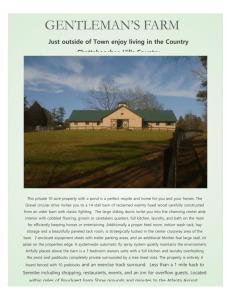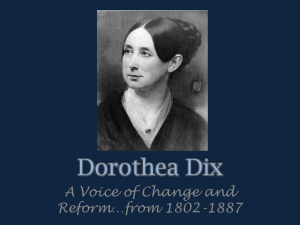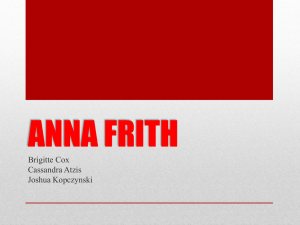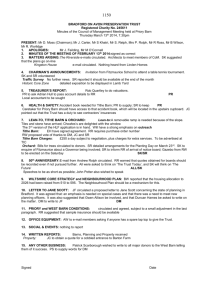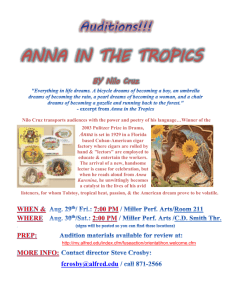Entire Session (Paper-Saving Version)
advertisement
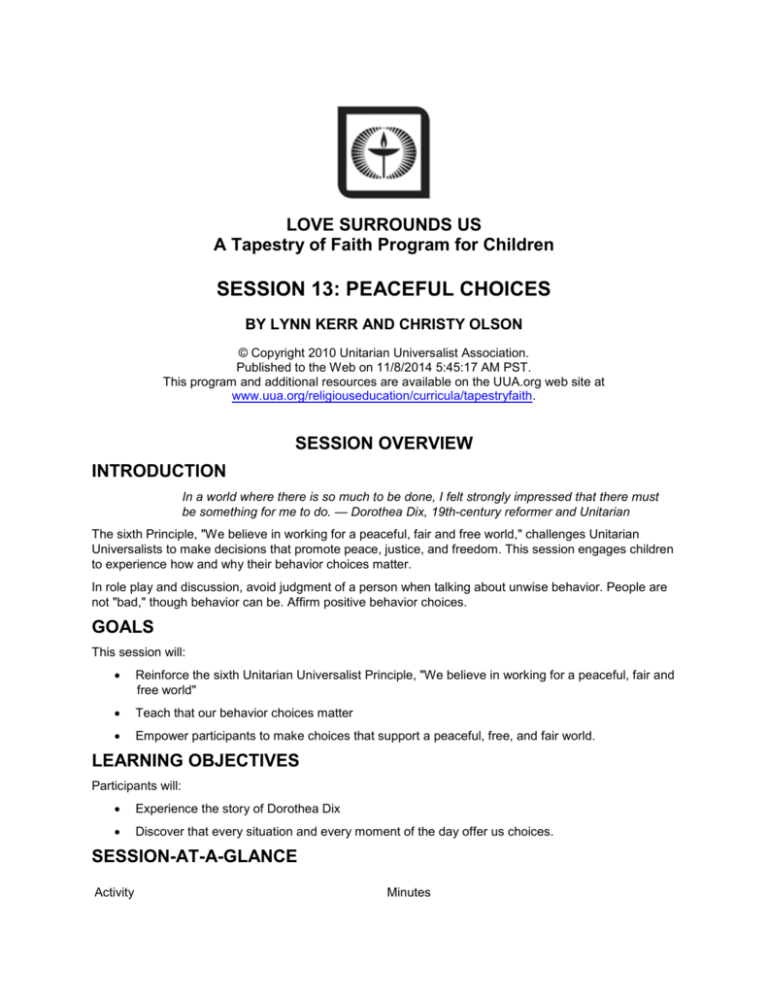
LOVE SURROUNDS US A Tapestry of Faith Program for Children SESSION 13: PEACEFUL CHOICES BY LYNN KERR AND CHRISTY OLSON © Copyright 2010 Unitarian Universalist Association. Published to the Web on 11/8/2014 5:45:17 AM PST. This program and additional resources are available on the UUA.org web site at www.uua.org/religiouseducation/curricula/tapestryfaith. SESSION OVERVIEW INTRODUCTION In a world where there is so much to be done, I felt strongly impressed that there must be something for me to do. — Dorothea Dix, 19th-century reformer and Unitarian The sixth Principle, "We believe in working for a peaceful, fair and free world," challenges Unitarian Universalists to make decisions that promote peace, justice, and freedom. This session engages children to experience how and why their behavior choices matter. In role play and discussion, avoid judgment of a person when talking about unwise behavior. People are not "bad," though behavior can be. Affirm positive behavior choices. GOALS This session will: Reinforce the sixth Unitarian Universalist Principle, "We believe in working for a peaceful, fair and free world" Teach that our behavior choices matter Empower participants to make choices that support a peaceful, free, and fair world. LEARNING OBJECTIVES Participants will: Experience the story of Dorothea Dix Discover that every situation and every moment of the day offer us choices. SESSION-AT-A-GLANCE Activity Minutes Welcoming and Entering 0 Opening 10 Activity 1: Story — Barn School, Free School 10 Activity 2: Role Play — Daily Choices Help Us Grow 20 Activity 3: Collage — What's in the Barn? 15 Faith in Action: Socks for Tired Feet Closing 5 Alternate Activity 1: Poster — Sixth Principle 10 SPIRITUAL PREPARATION Choices happen every minute of our day. A choice at a grocery store or a choice of a gift for a loved one shows our values. List the small but important choices you have made today. Next to each item, write the words peace, freedom, or fairness to indicate how that decision connects to the world. For instance, your list might say "changed a light bulb." Next to it might be the word "fairness" if you chose to replace a bulb with one that is energy efficient. Reflect on your list, and how you can bring a message of peaceful, free, and fair choices to young children. SESSION PLAN WELCOMING AND ENTERING Materials for Activity Ribbon sticks (or wrist ribbons) in a container (Session 1, Opening) Preparation for Activity If you have not previously made ribbons sticks or wrist ribbons for each child do it now as per instructions in Session 1, Opening. Place container of ribbon sticks by the door. Description of Activity Use this activity when children arrive individually—that is, straggle in—before the session begins. Welcome each child as they enter. Invite them to take their ribbon stick from the container by the door and move to the large group area. Invite them to find the indigo ribbon on their ribbon stick. Explain that indigo is a deep, bluish purple. As others arrive, engage participants to see who can remember the first five Principles and the colors represented on the ribbon stick. Including All Participants Give a ribbon stick to any new child or visitor and write their name on it. Provide wrist ribbons for children who are physically unable to wave a ribbon stick. Help attach wrist ribbons to wrists, legs, or fingers according to the mobility of the child. Provide a space at a work table for any child who is unable to sit at a chair. OPENING (5 MINUTES) Materials for Activity Ribbon sticks (or wrist ribbons) in a container (Session 1, Opening) Chalice, candle, and lighter or LED/battery-operated candle Session 1,Leader Resource 1, Rote Teaching — Love Surrounds Us Song (at www.uua.org/re/tapestry/children/lovesurrounds/session1/sessionplan/leaderresources/169850.s html) Indigo cloth for centering table Preparation for Activity If you have not previously made ribbons sticks or wrist ribbons for each child do it now as per instructions in Session 1, Opening. Spread the cloth on a centering table. Place the container filled with ribbon sticks and the chalice, candle, and lighter on the cloth. Check ribbon sticks to be sure all ribbons are still safely attached. Description of Activity Reinforce the first through fifth UU Principles and add the sixth Principle by repeating and matching the colors. Invite children to find their ribbon sticks and then come sit together. Welcome the children. Optional: Lead the group to sing the song "Love Surrounds Me." Have each child say their name and wave their ribbon stick above their head. Then, take a ribbon stick in your hand and invite the children to echo the Principles after you read each one: We believe each and every person is important. (Hold up the red ribbon) We believe all people should be treated fairly. (Hold up the orange ribbon.) In our congregations, all people are accepted and we learn together. (Hold up the yellow ribbon.) We believe each person is free to search for what is true and right in life. (Hold up the green ribbon.) Everyone deserves a say about the things that concern them. (Hold up the blue ribbon.) Now say: Today we will learn a new Principle. The sixth Principle is, "We believe in working for a peaceful, fair, and free world." Hold up the indigo ribbon and ask the children to find the indigo ribbons on their ribbon sticks. Tell them indigo represents the sixth Unitarian Universalist Principle. Lead the group to say the words again, with you. Lead the opening chant: Group chants "Love surrounds us everyday. The Principles show us the way." Leader says "______ please, put your ribbons away." (Child named returns their ribbon stick.) Guide children, as they are named, to return their ribbon stick to the container and then return to the circle. This is a way to acknowledge the presence of each participant. If the group is large, say only several names, then direct the others to put away their ribbon sticks all together and come back to the circle. When all the children have returned to the circle, say "Now we will light the chalice, the symbol of our Unitarian Universalist faith." Light the chalice. Lead the group to say together: Love surrounds the chalice and we are included by the light of the chalice. Including All Participants Help attach wrist ribbons (Session 1, Opening) to children's wrists, legs, or fingers, and later, help remove them, if any children are physically unable to use a ribbon stick. ACTIVITY 1: BARN SCHOOL, FREE SCHOOL (10 MINUTES) Materials for Activity A copy of the story "Barn School, Free School (included in this document) " Preparation for Activity Read the story several times; it has a lot of conversation. Practice using differing voices for each character. Description of Activity Participants will hear the story of an imagined result of Dorothea Dix's real life choice to begin a free school for the poor. Gather the children to hear a story. Say, in your own words: Dorothea Dix exemplified the UU Principles in her life choices. Born into a poor family, Dorothea took responsibility for her own life. She left home at the age of 12 and went to live with her grandparents in Boson. She chose to go to school and learn. Dorothea never forgot the lack of hope in her life when she was poor. She offered to teach a free school in the barn of her Grandmother's house. After a period of exhaustion, Dorothea was exposed to the plight of the mentally ill. Again Dorothea chose to take that experience and make the world a better place. For the rest of her life, Dorothea was an active reformer for the mentally ill. Dorothea Dix was a Unitarian woman who made choices to make the world fair for others. Lead a discussion with these process questions: Why did Dorothea choose to go to school and learn? How does going to school and learning help all of us learn to make good choices? Say, "Now let's hear the story about Dorothea Dix." Read/tell the story enthusiastically. Use these questions to process after the story. What do you think "free school" means? How did Dorothea use what she had to help others? How would you help poor people if you could? If you could choose to go to school or not to go to school, what would you choose? Why? How does going to school and getting an education help us follow the sixth Principle? ACTIVITY 2: ROLE PLAY, DAILY CHOICES HELP US GROW (20 MINUTES) Materials for Activity Leader Resource 1, Role Play Flowers (included in this document) Leader Resource 2, Role Play Situations (included in this document) Green construction paper A basket Masking tape or sticky tack Preparation for Activity Print out two copies of Leader Resource 1. Cut out eight strips of paper as indicated, each with a flower on its left-hand side. Print out Leader Resource 2. Cut out the eight blocks of text, each providing a role play situation. Glue or tape each block of text to a strip of paper from Leader Resource 1 that has a flower on it. Place all eight strips with flowers and text in the basket. Using green construction paper, make a 3-inch wide by 4-foot high green "stem" and attach it to a wall. Description of Activity This activity asks participants to make choices that support the sixth Principle. It generates a display for the meeting space which shows that positive choices help us grow. Center the group by asking them to breathe deeply in, count to five, and breathe out. If they are sitting on the floor, ask them to raise their arms in the air as they breathe in to improve posture. Ask participants how many choices they make in a day. (What to wear, when to get out of bed, which shoe to put on first.) Repeat and affirm their suggestions: We make lots of choices each day. Say, in these words or your own: We make choices everyday that help us grow. Today we will act out some situations that are found on these flowers. You will choose a flower and a partner and I will read the situation. Then you act it out and tell us about your choice. We will put the flowers on the big flower stem to remind us how we grow through our choices. Ask if there are any questions. Lead the children to choose, read, and enact role plays. After each role play, process with these two questions. How does your choice make the world more peaceful, fair, or free? What did you learn from making this choice? Then, attach the flower to the stem on the wall. When all the flowers are posted on the stem, say, "Look how much we have grown by making good choices." Including All Participants Invite physically or developmentally delayed participants to role play with a partner or as part of a small group. ACTIVITY 3: COLLAGE, WHAT'S IN THE BARN? (15 MINUTES) Materials for Activity Magazines and catalogs to cut up Construction paper — two sheets for each child, one red sheet and one sheet in another color Glue sticks and scissors (including left-handed scissors) Preparation for Activity Gather magazines or catalogs with diverse images of young children and pictures of school supplies. Cut sheets of red construction paper in half to make a set of barn doors to tape or glue on top of each child's collage. Make a sample of the project with the collage inside the barn door. Description of Activity This activity extends children's experience of the story "Barn School, Free School" (Activity 1). Participants will each make a barn that opens to show children at school inside. Show the children the barn sample. Ask them "What's in the barn?" They will answer all sorts of animals. Open the barn door and surprise them that there are children inside. Talk about the school that met in the barn. Invite volunteers to summarize the story. Distribute the construction paper you have not made into barn doors, along with magazines, scissors, and glue sticks for children to share. Invite participants to cut out pictures of children and school supplies and make a collage to make their own barn school. Distribute construction paper. Using glue sticks, they will glue all the magazine pictures on a piece of construction paper. As children finish, help them tape or glue on their barn doors to the edges of their collage. Process with these questions: I wonder what your family will expect behind the barn door. How will you tell about the barn school? Why is it important that Dorothea Dix taught school to poor children? How did Dorothea Dix make the world fair and free? Including All Participants Pre-cut pictures if the group includes very young children or some who may be unable to use scissors. CLOSING (5 MINUTES) Description of Activity Invite everyone to gather in a circle and hold hands. Start by squeezing the hand to your right and saying: "Today I found love, today I gave love." Lead the group to move the hand squeeze around the circle until everyone has had a chance to say the words. Then, invite the group to unclasp hands lead them to say the closing words in unison: Be good to yourself. Be excellent to others. Do everything with love. Including All Participants If participants do not want to hold hands, invite them to just say the words to the person to their right. If needed, repeat the words aloud with each child. FAITH IN ACTION: SOCKS FOR TIRED FEET Materials for Activity Several large cardboard boxes, such as appliance boxes Large roll of plain paper Permanent markers Clear packing tape Tempera paint and a cookie sheet with edges Two chairs A dishpan of soapy water, and towels Preparation for Activity Check the website of the organization Sharing and Caring Hands (at www.sharingandcaringhands.org) to learn about their mission and how to organize a collection of socks to donate. Roll out the paper. Hold it down with a chair on one end. At the other end, hold it down with a dishpan of soapy water and place towels nearby. At the "chair" end of the paper, set the cookie sheet. Pour paint into it. Description of Activity Participants will use paint-covered bare feet to decorate paper. Then, use the paper to wrap boxes for collecting socks to send to Sharing and Caring hands. Background Sharing and Caring Hands is a ministry started to help the poor no matter where they come from and no matter what their background. The people who receive aid are given socks, food, meals, or love, just because they need it. Ninety-three percent of donations received go to the poor. Tell the children about Sharing and Caring Hands, in these words or your own: Sharing and Caring Hands is a ministry that was started to serve those in need. Caring for the feet of the poor is an important part of Sharing and Caring Hands. Most of the transportation for the poor is through walking, yet some poor people do not have clean socks to protect their feet or shoes that fit them. Love is not just for those with six pair of shoes. Both Mary Jo Copeland of Sharing and Caring Hands and Dorothea Dix, who we learned about today, believed in caring for those in need. Gather the children at the "chair" end of the paper. Invite them, one at a time, to remove their shoes and socks. While holding an adult hand they will stand in the paint (this may be slippery depending on the surface of the pan) and walk across the paper. At the end of the paper the participant steps into the soapy water and washes their feet. Still holding an adult hand, they step on the towel to dry their feet. Shoes and socks are replaced when feet are dry. Let the painted footprints dry. Then, use the paper and clear packaging tape to wrap the large cartons. Write "Socks for Tired Feet — a Donation to Sharing and Caring Hands" with permanent marker on the boxes. Place the boxes around the congregation or, with permission, at local department stores. Collect socks and mail to Sharing & Caring Hands, 525 North 7th Street, Minneapolis, MN 55405. Including All Participants If a child is unable to stand or walk, help them make a painted footprint to place on the box. Take off shoe and sock. Paint the bottom of the foot with paint. Bring the paper to the foot. Wash the foot with a cloth and dry. Replace shoe and sock. LEADER REFLECTION AND PLANNING Reflecting on the time with your group, how do you feel the participants integrated the sixth Principle? Did they understand that they have choices leading to a peaceful, fair, and free world? Look ahead to the next session we will explore the Unitarian Universalist seventh Principle, "We believe in caring for our planet Earth and every living thing that shares it with us." Explore your feelings about the seventh Principle between now and the next session. TAKING IT HOME In a world where there is so much to be done, I felt strongly impressed that there must be something for me to do. — Dorothea Dix, 19th-century reformer and Unitarian IN TODAY'S SESSION... participants learned how the sixth Principle applied to the life of Unitarian social reformer, Dorothea Dix. They learned about a barn school and they talked about choices. Our daily choices make a difference in how we work toward a peaceful, free, and fair world. EXPLORE THE TOPIC TOGETHER. Talk about... choices children make each day. Affirm good choices that lead to a better world. Use these questions to talk about today's topic. What choices do we make everyday? Are there choices we make only occasionally? Share your hardest choice. EXTEND THE TOPIC TOGETHER. Try... A Family Adventure. Attend a buffet meal. Decide ahead how many choices each person may have. Discuss how those choices were made at the meal. See if you can determine how the food choices you made support fairness, justice, freedom, or peace. A Family Game. Set out many choices of games for a family game night. Together, choose a game to play that will help your family work together for a more peaceful, fair, and free world. A Family Ritual. Place a basket of stones, feathers, leaves, or flowers on the table. Each person will choose one item from the basket and say, "I chose this ___________ because it reminds me that to keep a free, fair and peaceful world I should, ________________________. ALTERNATE ACTIVITY 1: POSTER, SIXTH PRINCIPLE (10 MINUTES) Materials for Activity Handout 1, Poster — Sixth Principle (included in this document) Crayons and/or color markers Preparation for Activity Copy Handout 1 for all participants. Set crayons/markers at work tables. Description of Activity This activity invites participants to free draw and illustrate the sixth Principle. Read the sixth Principle to the participants: "We believe in working for a peaceful, fair, and free world." Ask participants to say the sixth Principle with you. Then, distribute the handout and invite the children to make a poster that illustrates the sixth Principle. Do not direct the drawing. Allow the children to use their imaginations in combination with what they have learned. LOVE SURROUNDS US: SESSION 13: STORY: BARN SCHOOL, FREE SCHOOL By Janeen Grohsmeyer. A story of Dorothea Dix (1802-1887), Unitarian teacher and social reformer. "Finish eating your supper, Anna," said Florence. "We mustn't be late to school." Anna nodded and ate another spoonful of soup. She was happy to get a piece of potato in the warm salty broth, instead of only cabbage. Usually she ate slowly, to make the food last longer, and usually after supper she stayed home. But she had turned six years old yesterday, and so tonight, her older sister Florence was taking her to school. "Why can't I go?" her older brother Michael asked. He had finished his soup. "You've already been," their mother answered. "Two full years at the public school. Now that you're twelve, you need to work. And you two girls need to be quick. Off you go!" Anna finished her soup. Then she and Florence put on shawls and bonnets and kissed their mother goodbye. Their father was a sailor, away at sea, so they couldn't kiss him. He had left two years before. Anna didn't remember him very well. Outside, the city of Boston smelled of dead fish and wet ropes, as always. Down at the harbor, the white sails on the tall ships snapped and billowed in the breeze, like sheets hung out to dry on a clothesline. "How far do we have to walk?" Anna asked, as she and Florence went down the alley. They lifted their skirts to keep them out of the mud and hopped over puddles. "Not far," Florence answered. "The school is at the teacher's house." "In her house?" Anna asked, wondering if they would meet in the kitchen. "Not in her house. At her house. Behind it. The school is in a barn." Now Anna wondered if they would meet in a stall. "Are there horses?" she asked hopefully. "Or chickens?" "No," said Florence. "The family doesn't keep horses or chickens anymore. The barn is clean." "I would have liked a chicken," Anna said wistfully. "Or a goat." The girls waited for a horse and cart to go by so they could cross a street. The horse's tail and mane were the dark gold color of straw, and its coat was a deep brown that looked red in the evening sunshine. Mother said a horse with those colors was called chestnut, just like the shiny, dark-brown nuts that people roasted to eat at Christmas time. The horse's hooves clip-clopped on the cobblestones as it went up the hill. The cart creaked along behind. The cobblestones felt cold and rough through the thin soles of Anna's shoes. She hoped Florence might get a pair of shoes before winter, and then give her old shoes to Anna to wear. They would have thin soles, too, but at least they wouldn't squeeze her toes. "What will we do at school?" Anna asked next. "After prayers, we sit at a long table and do lessons. We read and spell and do sums. Sometimes the teacher tells us about stars or how the mountains were made. In the summer we learned about flowers almost every day." Anna was pleased. She liked flowers and stars, and she wanted to learn about mountains, for she had never seen one. "What's the teacher's name?" Anna asked. "Miss Dorothea Dix," Florence told her. Anna repeated the name silently to herself so she wouldn't forget and practiced saying, "Good evening, Miss Dix" under her breath. She hoped Miss Dix would like her. Anna could tell from the houses that they were getting close to the school. Instead of small, wooden houses with unpainted shutters like the one she lived in, the houses on this street were very large, with window panes of glass. They had tall brick chimneys and shining brass handles on their doors. Many houses had barns out back. Some even had gardens. The girls passed a fine brick church. On the other side of the street Anna saw a dozen girls in pretty dresses sitting in a garden. All of them were busy sewing. "Is that the school?" Anna asked, for she knew twelve girls couldn't all be sisters. "That's Mrs. Rowson's Female Academy for young ladies," Florence said. "Girls come from all over the country to attend. I hear it's very expensive." "Is our school expensive?" Anna asked, suddenly worried. Their family couldn't afford an expensive school. Their family couldn't afford new shoes. Some days they couldn't afford food. Mother worried about money all the time. "No," Florence said. "Our school is free." "Free?" Anna repeated in surprise. "Free," her sister said firmly. "During the day, Miss Dix teaches a class for young ladies, and they have to pay. In the evening, Miss Dix teaches children like us, and it's free." Anna didn't know many people who did things for free. "Why does she do that?" "Miss Dix believes it's everyone's duty to help each other. She says that those who have enough have a special duty to give to those who don't. Some people give money; Miss Dix gives a school." "A school in a barn," Anna said, but she didn't mind. She was just glad to have a school. Their family couldn't afford to pay, and girls couldn't go to public schools like their brother had. Their mother had never been to school at all. "A free school," Anna said. "A barn school." She liked the sound of that so much she said it again, skipping along with the words: "Barn school, free school. Barn school, free school." Florence started skipping too. "Barn school, free school," they chanted until finally Florence stopped. "Here's the barn," she said. "And here's the school." In front of them was a very large house in a garden. Beautiful flowers lined all the paths, and Anna realized that the air didn't smell like dead fish and wet ropes anymore. It smelled soft and fresh and sweet. Off to one side was a little cottage and farther back was the barn. A row of trees stood tall against a fence. "Those are Dix pear trees," Florence said. "Miss Dix's grandfather developed them years ago. The pear I brought home last month grew from those trees." Anna remembered that pear. She and her mother and brother and Florence had each had one slice. Anna had never eaten a pear before, and she had thought it was most delicious thing in the whole world. "Her grandmother lives in the cottage, along with Miss Dix," Florence explained as they walked down one of the paths between the beautiful flowers. "They rent the big house to other people." "And they let us use the barn for free!" Anna said in delight. She might have started skipping and chanting "Barn school, free school" again, but then she saw Miss Dix, standing at the door of the barn. Miss Dix was tall and slender. She wore a pretty blue gown with tiny white ruffles at the sleeves and a soft white shawl around her shoulders. She wasn't old at all. Her hair was a deep brown touched with red, just like the chestnut color of the horse. "Good evening, Florence," she said, and her voice was soft and sweet, just like the scent of the air. "Good evening, Miss Dix," Florence replied. "Good evening, Miss Dix," Anna repeated, just as she'd practiced. "This is my sister, Anna," Florence explained. "She's six years old, and she wants to learn." "Good evening, Anna," Miss Dix said, and her smile was as beautiful as the flowers. "Welcome to the school. I'm glad you're here." Anna smiled back. "Thank you, Miss Dix. I'm glad I'm here, too." They went inside, and Florence showed her where to hang their shawls and bonnets. As Anna sat at the long table and started on her very first lesson, she chanted very softly: "Barn school. Free school." And then she whispered, "Thank you, Miss Dorothea Dix." LOVE SURROUNDS US: SESSION 13: HANDOUT 1: POSTER, SIXTH PRINCIPLE Unitarian Universalist Sixth Principle We believe in working for a peaceful, fair, and free world. LOVE SURROUNDS US: SESSION 13: LEADER RESOURCE 1: ROLE PLAY FLOWERS LOVE SURROUNDS US: SESSION 13: LEADER RESOURCE 2: ROLE PLAY SITUATIONS Your Mom wakes you up. Do you choose to get up immediately or snuggle in for a few more moments? Your little brother is late for the bus. You get on the bus. Do you say anything to the bus driver? Your best friend accidently drops her backpack and dumps it in the busy hallway. What do you do? Your dog is whining at the door to go outside. But the dog is your big sister's job. What do you do? You get to your after-school program and the regular teacher is not there. There is a substitute who doesn't know everyone's name. Can you help? You get to watch a family movie. Your siblings pick one you don't like. What do you do? Your friends will all be at a birthday party on Sunday but the rest of your family is going to visit your grandmother. You have not seen your grandmother for a long time, but, your mom says it's up to you. What will you do? You've played six innings while your best friend sits on the bench. The coach gives you a choice to play or rest. What do you choose? FIND OUT MORE Dorothea Dix Two books include Breaking the Chains: The Crusade of Dorothea Lynde Dix by Penny Colman (ASJA Press, 2007) and Dorothea Dix: Social Reformer by Barbara Witteman (Bridgestone Books, 2003). Barns In different areas of the United States, people built different kinds of barns. See a history of barns at the Antique Farming (at www.antiquefarming.com/barn) website. A children's book is Tuttle's Red Barn by Richard Michelson (Putnam Juvenile, 2007). A book with pictures is The Ultimate Book of Historic Barns: History, Legend, Lore, Form, Function, Symbolism, Romance by Robin Langley Sommer (Thunder Bay Press, 2000).
